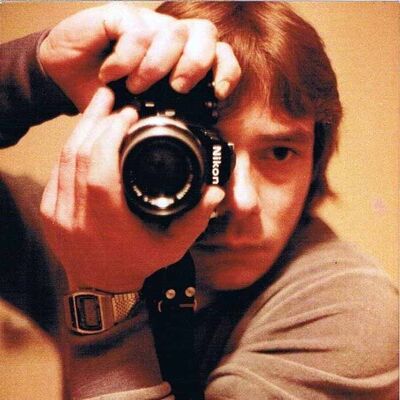ZOOM
Dec 30, 2015 23:32:21 #
mwsilvers
Loc: Central New Jersey
To follow up on what others have said, remember that the numbers only have meaning when shooting at infinity. Close in, the ratio between wide and long will be different than at infinity, and it will also be different when comparing different models and manufacturers.
Dec 30, 2015 23:53:59 #
blackest wrote:
This is an odd one I am not sure and I can't find ... (show quote)
The "X" number for a zoom lens isn't to denote what the longest focal length is compared to a "normal" lens, it's to denote the range between the shortest and longest focal lengths. So your 25 to 200 lens is indeed 8X, and remains that no matter what size sensor it is on.
Dec 31, 2015 00:16:50 #
JohnSwanda wrote:
The "X" number for a zoom lens isn't to denote what the longest focal length is compared to a "normal" lens, it's to denote the range between the shortest and longest focal lengths. So your 25 to 200 lens is indeed 8X, and remains that no matter what size sensor it is on.
So what about the 75-300mm ? Is that 4X although it clearly has more reach than the 25-200mm.
your definition seem to be the range of magnification available to that lens.
Would it confuse things further if i mentioned binoculars which might be sold as 10X typically but only have 1 focal length?
Dec 31, 2015 00:20:57 #
imagemeister wrote:
Yes, SORRY so what is then then 40 something ???????
Check recent threads. There is a discussion as to the length of a "normal" lens in 35mm format.
Dec 31, 2015 04:02:09 #
blackest wrote:
So what about the 75-300mm ? Is that 4X although it clearly has more reach than the 25-200mm.
your definition seem to be the range of magnification available to that lens.
Would it confuse things further if i mentioned binoculars which might be sold as 10X typically but only have 1 focal length?
your definition seem to be the range of magnification available to that lens.
Would it confuse things further if i mentioned binoculars which might be sold as 10X typically but only have 1 focal length?
There could certainly be confusion there. With binoculars the X-number refers to the magnification. With 10x binoculars an object appears to be 10 times as close as when viewed with the naked eye.
It would get really confusing if one tried to apply the zoom range nomenclature used to describe camera lenses to variable power binoculars. For instance you might have a 12-36 x 70 binocular. That means that it magnifies from 12 to 36 times and has an objective lens diameter of 70mm. That would be a 3x zoom if described that same way as camera lenses.
Dec 31, 2015 06:34:19 #
billnikon
Loc: Pennsylvania/Ohio/Florida/Maui/Oregon/Vermont
Linda From Maine wrote:
The Canon SX50 has an equivalent range of 24 - 1200 mm.
I get it, so 1200 divided by 24 is 50, so the Canon SX50 has a 50X zoom lens, hence the name of the camera, Canon SX50.
Dec 31, 2015 06:50:30 #
blackest wrote:
So what about the 75-300mm ? Is that 4X although it clearly has more reach than the 25-200mm.
your definition seem to be the range of magnification available to that lens.
Would it confuse things further if i mentioned binoculars which might be sold as 10X typically but only have 1 focal length?
your definition seem to be the range of magnification available to that lens.
Would it confuse things further if i mentioned binoculars which might be sold as 10X typically but only have 1 focal length?
The use of the X to describe the magnification of binoculars has a different meaning than denoting the range of a zoom lens - apples and oranges. Again, the X for zoom lenses does not denote the reach of the longest focal length of a zoom.
Dec 31, 2015 08:11:34 #
charles tabb wrote:
I want to ask a question.
It's probebly a stupid one....
How can I convert 7X to mm for instance or reverse?
I keep looking at cameras that have say a 300 mm lens
or say it has a 7X zoom lens.
It's probebly a stupid one....
How can I convert 7X to mm for instance or reverse?
I keep looking at cameras that have say a 300 mm lens
or say it has a 7X zoom lens.
As has already been stated, it is the multiple of the minimum focal length. ie: 18-55mm = 3X zoom range, 50-300mm = 6X zoom range, 18-140mm = 8X range (aprox)
I would also mention that a multiple of X in reference to a single focal length lens can also be a reference to it's magnification at a given format. ie: 100mm lens Full Frame = 2X mag. 70mm DX = 2X mag.
The multiple of X refers to the multiple of "normal" perspective. (Like binoculars)
ie: FF = 50mm, DX = 36mm "Normal" or 1X (aprox).
210mm @FF = 4.2X, 210mm @DX = 6X, The "X" factor being lens magnification.
Dec 31, 2015 08:16:44 #
Hi Charles,
Perhaps you can explain the reason why you want to make the conversion. That may provoke a more detailed answer.
Mark
Perhaps you can explain the reason why you want to make the conversion. That may provoke a more detailed answer.
Mark
charles tabb wrote:
I want to ask a question.
It's probebly a stupid one....
How can I convert 7X to mm for instance or reverse?
I keep looking at cameras that have say a 300 mm lens
or say it has a 7X zoom lens.
It's probebly a stupid one....
How can I convert 7X to mm for instance or reverse?
I keep looking at cameras that have say a 300 mm lens
or say it has a 7X zoom lens.
Dec 31, 2015 08:22:24 #
Zoom ratings have gotten confusing, mainly because we no longer use 35mm as the standard. If all cameras listed their zoom range in 35mm terms, there would be no confusion. A compact camera might have a zoom range of 14mm-98mm, which would be 7X. Depending on the size of the sensor, that could be the 35mm equivalent of 28-70mm. That's the figure that should be displayed prominently.
Then, of course, you have to consider optical vs digital zoom, another kettle of fish.
Then, of course, you have to consider optical vs digital zoom, another kettle of fish.
Dec 31, 2015 08:39:18 #
JohnSwanda wrote:
The use of the X to describe the magnification of binoculars has a different meaning than denoting the range of a zoom lens - apples and oranges. Again, the X for zoom lenses does not denote the reach of the longest focal length of a zoom.
Seems like the zoom range of a lens is pretty much junk.
Having 3X 5X or 10x tells you pretty much meaningless information about a lens. The only value is for marketing really.
The 50mm normal lens based on the diagonal of a 24x36mm negative well that diagonal is about 43mm so kind of nominal too.
field of view that is different between eye and lens.
maybe there is a magnification factor that relates what you see with your naked eye with what you see through a lens but I don't know it.
focal length and a multiplier seems to be the best we have to compare lenses.
Dec 31, 2015 10:19:05 #
billnikon wrote:
I get it, so 1200 divided by 24 is 50, so the Canon SX50 has a 50X zoom lens, hence the name of the camera, Canon SX50.
--------
You are correct and it's the answer to the original question.
The X is the spread.
Dec 31, 2015 11:05:14 #
Lots of complication here, and some mathematically incorrect answers.
Firstly, forget any link between the 7x (or whateverX) and any specific focal length. It just tells you roughly the ratio between the lens's focal length at its longest, divided by the focal length at its widest. So a DSLR lens from 18-270mm is 15X, but my Tamron 150-600 is only 4X, even though its maximum focal length is more than double.
To fully understand the figures, you also need to know the sensor size, and how it relates to the 35mm which has been chosen as a default standard.
You mentioned the binoculars. It's entirely equivalent to the camera lenses.- the human eye has a focal length of about 20mm, so your 10X binocular added to your human lens system produces a focal length of 200mm in total. This effectively reduces the apparent distance to the object to one tenth. This might help: http://www.cambridgeincolour.com/tutorials/cameras-vs-human-eye.htm
Firstly, forget any link between the 7x (or whateverX) and any specific focal length. It just tells you roughly the ratio between the lens's focal length at its longest, divided by the focal length at its widest. So a DSLR lens from 18-270mm is 15X, but my Tamron 150-600 is only 4X, even though its maximum focal length is more than double.
To fully understand the figures, you also need to know the sensor size, and how it relates to the 35mm which has been chosen as a default standard.
You mentioned the binoculars. It's entirely equivalent to the camera lenses.- the human eye has a focal length of about 20mm, so your 10X binocular added to your human lens system produces a focal length of 200mm in total. This effectively reduces the apparent distance to the object to one tenth. This might help: http://www.cambridgeincolour.com/tutorials/cameras-vs-human-eye.htm
Dec 31, 2015 11:52:26 #
charles tabb wrote:
I want to ask a question.
It's probebly a stupid one....
How can I convert 7X to mm for instance or reverse?
I keep looking at cameras that have say a 300 mm lens
or say it has a 7X zoom lens.
It's probebly a stupid one....
How can I convert 7X to mm for instance or reverse?
I keep looking at cameras that have say a 300 mm lens
or say it has a 7X zoom lens.
To see what 7X really means (specific to each camera make and model)
and compare the camera's magnification power to a 300 mm lens (50 div. into 300 = 6X)
check the camera's detailed specs.
e.g.
Canon PowerShot ELPH 160
Lens: Optical Zoom = 8X
Focal Length: 5.0 40.0 mm
35 mm Equivalent: 28 224 mm
Nikon COOLPIX P610
Lens: Optical Zoom = 60X
Focal Length: 4.3 258 mm
35 mm Equivalent: 24 1440 mm
Dec 31, 2015 12:47:04 #
Algernon
Loc: Milwaukee, Wisconsin
Edited to add: Oops, didn't see that there was a second page to this thread, and many others have answered this better than me.
Well, actually that is right. The x multiplier is simply the longest focal length divided by the shortest focal length, as previously mentioned.
A 8x zoom is not necessarily zooming in closer than a 4x zoom. It depends on the focal length range of the lens.
I'm sure my answer is not going to be definitive. If you want to determine an equivalence between two different camera sensor sizes, then you would first normalize them to a full frame equivalent.
After the normalization, then you can compare them depending on the focal lengths.
For example:
Full Frame camera, 50-300mm lens = 6x zoom, with a maximum zoom of 300mm.
APS-C camera (1.5 crop factor), 35-210mm lens = 6x zoom, with a maximum equivalent zoom of 315mm.
blackest wrote:
The longest focal length divided by the shortest focal length on a lens doesn't sound right lets take a 75-300mm and a 25-200mm
well 300/75 = 4 and 200 /25 = 8
so the longer lens is 4x zoom and the shorter 8x that can't be right.
The longest focal length divided by the shortest focal length on a lens doesn't sound right lets take a 75-300mm and a 25-200mm
well 300/75 = 4 and 200 /25 = 8
so the longer lens is 4x zoom and the shorter 8x that can't be right.
Well, actually that is right. The x multiplier is simply the longest focal length divided by the shortest focal length, as previously mentioned.
A 8x zoom is not necessarily zooming in closer than a 4x zoom. It depends on the focal length range of the lens.
blackest wrote:
These super zoom cameras have tiny sensors and very short focal lengths but are "equivalent" to massive full frame zoom lenses at least in terms of field of view.
so if we take actual 35mm lenses and put them on say a m43 camera
the 300mm is now a 12x zoom and 200mm an 8x zoom (on that body).
So does a magnification factor have any meaning without a frame of reference?
I look forward to seeing a definitive answer :)
These super zoom cameras have tiny sensors and very short focal lengths but are "equivalent" to massive full frame zoom lenses at least in terms of field of view.
so if we take actual 35mm lenses and put them on say a m43 camera
the 300mm is now a 12x zoom and 200mm an 8x zoom (on that body).
So does a magnification factor have any meaning without a frame of reference?
I look forward to seeing a definitive answer :)
I'm sure my answer is not going to be definitive. If you want to determine an equivalence between two different camera sensor sizes, then you would first normalize them to a full frame equivalent.
After the normalization, then you can compare them depending on the focal lengths.
For example:
Full Frame camera, 50-300mm lens = 6x zoom, with a maximum zoom of 300mm.
APS-C camera (1.5 crop factor), 35-210mm lens = 6x zoom, with a maximum equivalent zoom of 315mm.
If you want to reply, then register here. Registration is free and your account is created instantly, so you can post right away.








